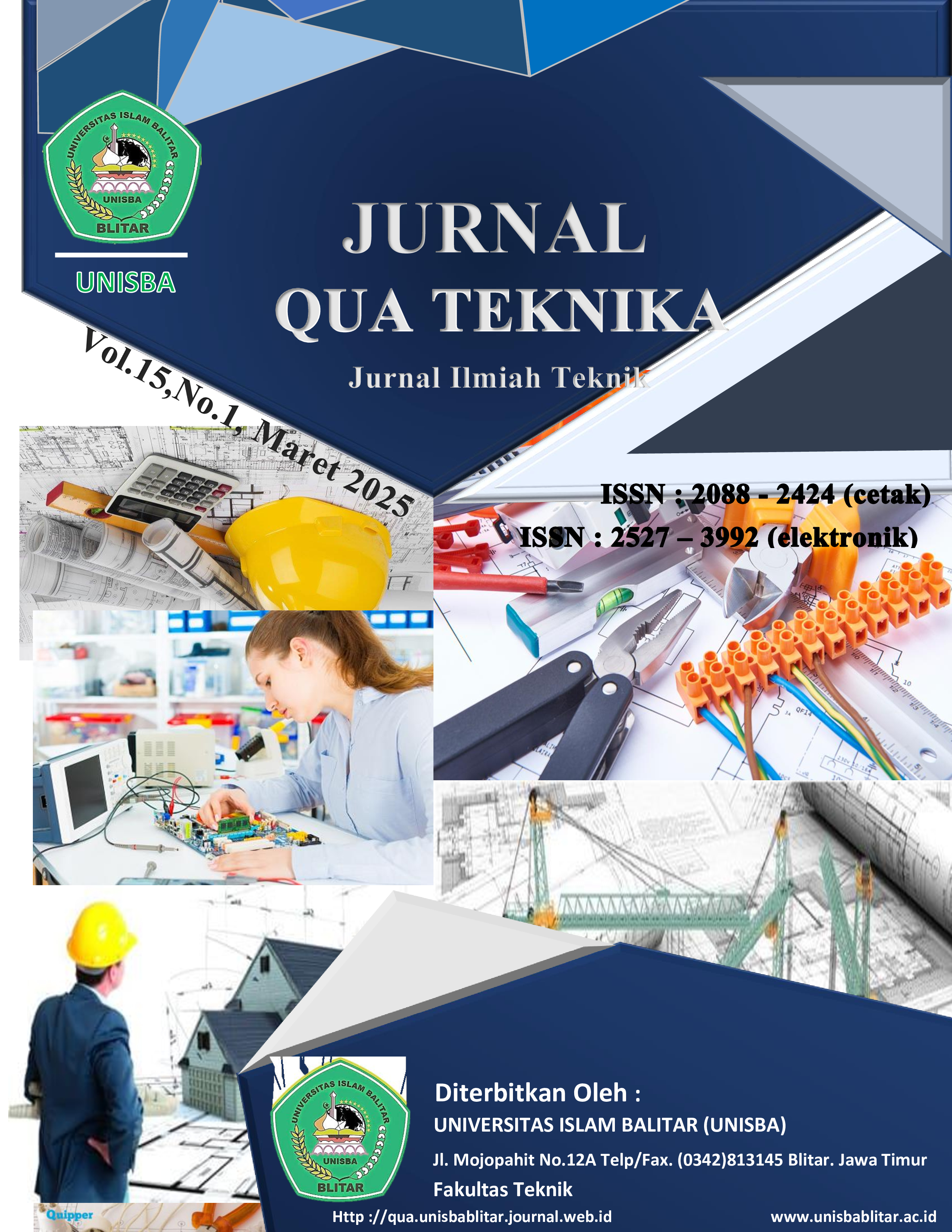PERFORMANCE ANALYSIS OF THE NON-SIGNALED SIMPANG THREE ROAD THAMRIN-JALAN RAYA DIPONEGORO, LAWANG DISTRICT, MALANG DISTRICT
DOI:
https://doi.org/10.35457/quateknika.v15i01.4316Keywords:
Unsignalized Intersection, Volume, Capacity, Intersection PerformanceAbstract
Malang District is a growing area in Java with a high population. Lawang sub-district has 111,440 residents with a growth of 0.31% in Malang Regency. Intersections are areas where roads intersect, and road intersections are prone to accidents. Research on the unsignalized triple intersection at Jalan Raya Thamrin - Jalan Diponegoro aims to understand the characteristics and find solutions to the problems in the area. Primary and secondary data were gathered through firsthand observation in the field. Data analysis was conducted to determine the pattern and size of the intersection in accordance with the surrounding environmental conditions.
References
M. Sa’dillah and R. A. Primasworo, “Kinerja Simpang Bersinyal Ruas Jalan Semeru – Kahuripan – Basuki Rahmat setelah Pembangunan Whiz Prime Hotel Malang,” J. Fondasi, vol. 9, no. 2, p. 103, 2020, doi: 10.36055/jft.v9i2.8467.
Z. Fatima, D. Silva, G. Damar Pandulu, and M. Sadillah, “Evaluasi Kinerja Simpang dengan Alat Pemberi Isyarat Lalu Lintas (APILL) di Kota Malang (Studi kasus : jalan Sumber sari-jalan Veteran-jalan Bendungan sutami-jalan Sigura-gura),” Pros. SENTIKUIN (Seminar Nas. Teknol. Ind. Lingkung. dan Infrastruktur), vol. 4, p. B6.1-B6.10, 2021, [Online]. Available: https://pro.unitri.ac.id/index.php/sentikuin
M. Sa’dillah, A. K. Arifianto, and E. Pradiatmo, “Analisis Kinerja Simpang Tak Bersinyal Dengan Menggunakan Metode Gap Acceptance Dalam Upaya Mengatasi Kemacetan,” Rekayasa J. Tek. …, vol. 5, no. 2, 2023, [Online]. Available: http://36.88.105.228/index.php/jurnal_rekayasa_teknik_sipil/article/view/2013%0Ahttp://36.88.105.228/index.php/jurnal_rekayasa_teknik_sipil/article/download/2013/1193
D. J. B. M. Kementrian Pekerjaan Umum, Pedoman Kapasitas Jalan Indonesia. 2023.
D. J. B. Marga, “Manual Kapasitas Jalan Indonesia (MKJI),” 1997, Departemen Pekerjaan Umum, Jakarta.
M. I. Sidiq, D. Nurmayadi, and F. Sholahudin, “ANALISIS KINERJA SIMPANG TAK BERSINYAL (Studi Kasus Di Simpang 3 Kudang, Singaparna, Kabupaten Tasikmalaya),” Teras J. J. Tek. Sipil, vol. 11, no. 2, p. 329, 2021, doi: 10.29103/tj.v11i2.501.
M. Sa’dillah, A. K. Arifianto, and I. Bule, “PERFORMANCE INTERSECTION OF PANGLIMA SUDIRMAN – UNTUNG SUROPATI NORTH STREET OF MALANG CITY,” J. Innov. Civ. Eng., vol. 4, no. 2, pp. 109–115, 2023.
H. B. B. Kuncoro, D. E. Intari, and R. Rahmayanti, “ANALISIS KINERJA SIMPANG TIGA TAK BERSINYAL ( Studi Kasus : Simpang Tiga Jalan Raya Serang Km 24 – Jalan Akses Tol Balaraja Barat, Balaraja, Kabupaten Tangerang, Banten ),” Fondasi J. Tek. Sipil, vol. 8, no. 1, pp. 61–69, 2019, doi: 10.36055/jft.v8i1.5402.
W. I. Dharmawan, D. Oktarina, and A. Brilianto, “Analisis Kinerja Simpang Tak Bersinyal (Studi Kasus: Simpang Jl. Imam Bonjol – Jl. Pagar Alam Kota Bandar Lampung),” Pros. SNST ke-9 Tahun 2018 , vol. 9, no. D, pp. 1–4, 2018.
G. Dhikri, W. Wibowo, S. T. Lestarini, and N. Faqih, “Analisis Kinerja Simpang 3 Tak Bersinyal Kecamatan Weleri Kabupaten Kendal,” Teras, vol. 11, no. 4, pp. 16–20, 2021.
M. Sa’dillah, R. A. Primasworo, and W. R. R. Raso, “Evaluasi Kinerja Simpang Tiga Jl . Trunojoyo – Jl . Kertanegara,” vol. 1, no. 4, pp. 401–412, 2022.
M. Sa’dillah, P. D. Rahma, and C. S. Tawong, “Analysis of the Unsignalized Intersection of Muharto Road, Ki Ageng Gribig Road, and Mayjend Sungkono Road,” J. Innov. Civ. Eng., vol. 4, no. 1, pp. 13–20, 2023, doi: 10.33474/jice.v4i1.19272.
I. I. Rahmi, P. Astuti, and F. Asteriani, “Pengembangan Ruang Pejalan Kaki Sudirman City Walk di Kota Pekanbaru,” 2015.
M. D. M. Pratama and E. Elkhasnet, “Analisis Kinerja Simpang Tak Bersinyal Jalan A.H. Nasution dan Jalan Cikadut, Kota Bandung. (Hal. 116-123),” RekaRacana J. Tek. Sipil, vol. 5, no. 2, p. 116, 2019, doi: 10.26760/rekaracana.v5i2.115.
Y. M. Syah, “Pengaruh Amburukmo Plaza Terhadap Kinerja Ruas Jalan Laksda Adisucipto (The Effect Of Ambarukmo Plaza On The Performance Of Laksda Adisucipto Road Section),” 2019.
Downloads
Published
Issue
Section
License
Copyright (c) 2025 Jurnal Qua Teknika

This work is licensed under a Creative Commons Attribution-ShareAlike 4.0 International License.
Authors who publish with this journal agree to the following terms:
- Copyright on any article is retained by the author(s).
- Author grant the journal, right of first publication with the work simultaneously licensed under a Creative Commons Attribution License that allows others to share the work with an acknowledgement of the work’s authorship and initial publication in this journal.
- Authors are able to enter into separate, additional contractual arrangements for the non-exclusive distribution of the journal’s published version of the work (e.g., post it to an institutional repository or publish it in a book), with an acknowledgement of its initial publication in this journal.
- Authors are permitted and encouraged to post their work online (e.g., in institutional repositories or on their website) prior to and during the submission process, as it can lead to productive exchanges, as well as earlier and greater citation of published work.
- The article and any associated published material is distributed under the Creative Commons Attribution-ShareAlike 4.0 International License
Deprecated: json_decode(): Passing null to parameter #1 ($json) of type string is deprecated in /home/ejournal.unisbablitar.ac.id/public_html/plugins/generic/citations/CitationsPlugin.php on line 68










